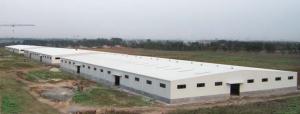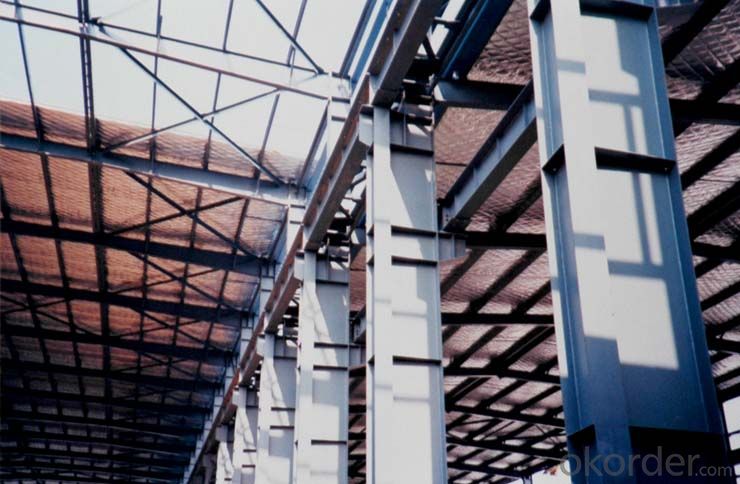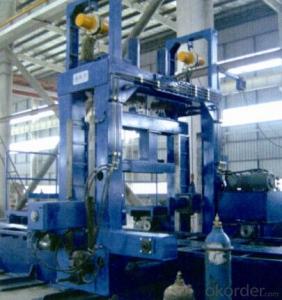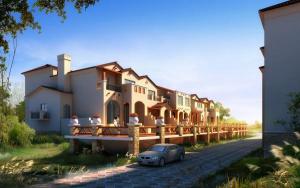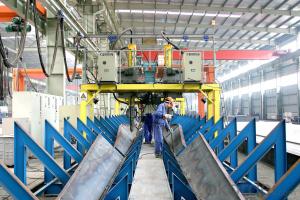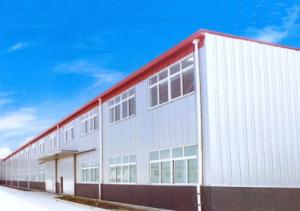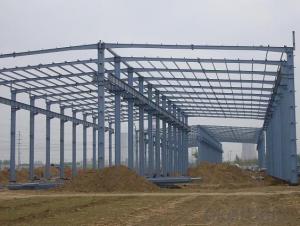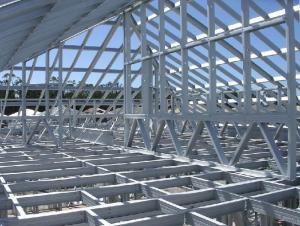Section Steel House Installation
- Loading Port:
- China Main Port
- Payment Terms:
- TT OR LC
- Min Order Qty:
- -
- Supply Capability:
- -
OKorder Service Pledge
OKorder Financial Service
You Might Also Like
Section Steel House Installation
1.The steel structure of the connection method: welding connection
2.Steel structure design common norms are as follows: "Steel Design Code" Cold formed steel structure technical specifications" (GB500182002) "Construction Quality Acceptance of Steel" "Technical Specification for welded steel structure" (JGJ812002, J218 2002) "Technical Specification for Steel Structures of Tall Buildings"
3.The characteristics of steel Light weight steel structure Higher reliability of steel work Steel anti-vibration (earthquake), impact and good Steel structure for a higher degree of industrialization Steel can be assembled quickly and accurately Large steel interior space Likely to cause sealing structure Steel corrosive Poor fire-resistant steel Recyclable steel shorter duration.
4.Commonly used steel grades and performance of steel Carbon
structural steel: Q195, Q215, Q235, Q255, Q275, etc.
Strength low alloy structural steel Quality carbon structural steel and alloy structural steel Special purpose steel Product Feature Carport, House, Office, Shop, Toilet, Villa, Warehouse, Workshop, Plant Other Information.
Products have been all over the country more than 20 provinces, municipalities and autonomous regions, and have been exported to Europe, North America, the Middle East, Africa, Asia and other countries and regions, the widespread use.
Packaging & Delivery of metal building steel structure
1. According to the project design and the component size, usually the main component parts are nude packing and shipped by bulk vessel. And the small parts are packed in box or suitable packages and shipped by containers.
2. This will be communicated and negotiated with buyer according to the design.
Engineering Design Software of metal building steel structure
Tekla Structure \ AUTO CAD \ PKPM software etc
⊙Complex spatial structure project detailed design
⊙Construct 3D-model and structure analysis. ensure the accuracy of the workshop drawings
⊙Steel structure detail ,project management, automatic Shop Drawing, BOM table automatic generation system.
⊙Control the whole structure design process, we can obtain higher efficiency and better results
Usage/Applications of steel structure/steel frame
Characters of Structure Steel
1. Steel is characterized by high strength, light weight, good rigidity, strong deformation capacity, so it is suitable for construction of large-span, super high and super-heavy buildings particularly;
2. It with good homogeneous and isotropic, is an ideal elastomer which perfectly fits the application of general engineering;
3. The material has good ductility and toughness, so it can have large deformation and it can well withstand dynamic loads;
4. Steel structure’s construction period is short;
5. Steel structure has high degree of industrialization and can realize-specialized production with high level of mechanization.
Steel structure application
1. Heavy industrial plants: relatively large span and column spacing; with a heavy duty crane or large-tonnage cranes; or plants with 2 to 3 layers cranes; as well as some high-temperature workshop should adopt steel crane beams, steel components, steel roof, steel columns, etc. up to the whole structure.
2. Large span structure: the greater the span of the structure, the more significant economic benefits will have by reducing the weight of the structure
3. Towering structures and high-rise buildings: the towering structure, including high-voltage transmission line towers, substation structure, radio and television emission towers and masts, etc. These structures are mainly exposed to the wind load. Besides of its light weight and easy installation, structure steel can bring upon with more economic returns by reducing the wind load through its high-strength and smaller member section.
4. Structure under dynamic loads: As steel with good dynamic performance and toughness, so it can be used directly to crane beam bearing a greater or larger span bridge crane
5. Removable and mobile structures: Structure Steel can also apply to movable Exhibition hall and prefabricated house etc by virtue of its light weight, bolt connection, easy installation and uninstallation. In case of construction machinery, it is a must to use structure steel so as to reduce the structural weight.
- Q: What is the role of steel canopies in a residential structure?
- The primary purpose of steel canopies in residential structures is to protect and enhance the building's aesthetic appeal. Typically positioned above entryways, windows, or outdoor living spaces, steel canopies shield these areas from rain, snow, and excessive sunlight. Acting as a barrier against harsh weather conditions, they prevent water from penetrating the building and keep occupants dry when entering or exiting. Furthermore, steel canopies also serve as architectural features, contributing a stylish and modern element to the overall residential design. They can be customized in various shapes, sizes, and finishes to complement the exterior of the building and create a distinctive visual impact. Steel canopies can be combined with lighting fixtures or designed to accommodate climbing plants, further enhancing the visual appeal of the residential structure. To sum up, steel canopies play a vital role in residential structures, providing protection from the elements while adding an aesthetically pleasing touch to the overall design.
- Q: How are steel structures used in marine and offshore structures?
- Steel structures are widely used in marine and offshore structures due to their exceptional strength, durability, and resistance to corrosion. These structures are employed in various applications, including offshore platforms, ships, marine terminals, and other marine infrastructure. In offshore platforms, steel is the preferred material for constructing the main structure, such as the jacket or the topside modules. The jacket, a lattice-like structure that supports the platform above the water, is typically made of steel trusses or tubular members. This design provides stability against the harsh marine environment, strong ocean currents, and extreme weather conditions. Steel platforms are capable of withstanding heavy loads and provide a stable foundation for drilling operations, production facilities, and accommodation units. Ships, especially those used for commercial shipping or offshore operations, rely heavily on steel structures. The hull of a ship is typically made of steel plates, which offer high strength and resistance to corrosion from saltwater. Steel is also used to construct various components of the ship, including the superstructure, decks, and bulkheads. These structures provide structural integrity to the vessel and protect it from the harsh marine environment. Marine terminals, such as ports and harbors, utilize steel structures for various purposes. Steel sheet pile walls are commonly used to create quay walls, which provide berthing facilities for ships. These walls offer stability and prevent soil erosion, while withstanding the forces exerted by the ship during mooring and loading operations. Additionally, steel structures are used in the construction of jetties, breakwaters, and other marine infrastructure to enhance navigation and provide protection against waves and currents. The use of steel in marine and offshore structures is particularly advantageous due to its high strength-to-weight ratio. This allows for the construction of lightweight yet robust structures, reducing material and transportation costs. Furthermore, steel can be fabricated into various shapes and sizes, enabling the customization of structures to suit specific design requirements. To ensure the longevity of steel structures in marine and offshore environments, protective measures are implemented. These include the application of coatings and paints to prevent corrosion and the use of cathodic protection systems to counteract the electrochemical reactions that lead to rusting. Overall, steel structures play a crucial role in marine and offshore applications, offering strength, durability, and resistance to the harsh marine environment. They enable the construction of safe and efficient platforms, ships, and marine infrastructure, supporting various industries such as oil and gas, shipping, and port operations.
- Q: How are steel structures used in cold storage warehouses and facilities?
- Steel structures are commonly used in cold storage warehouses and facilities due to their strength, durability, and ability to withstand extreme temperatures. Steel provides the necessary support and stability for large storage spaces, allowing for efficient use of the available space. Additionally, steel structures can be easily customized and expanded to accommodate changing storage needs. The use of steel also ensures the safety of the cold storage environment, as it is resistant to fire and pests, and can withstand heavy loads and harsh weather conditions.
- Q: How are steel structures used in the construction of convention centers and exhibition halls?
- Steel structures are commonly used in the construction of convention centers and exhibition halls due to their strength, durability, and flexibility. Steel frames provide a solid foundation and support for large, open spaces, allowing for vast exhibition areas without the need for columns or load-bearing walls. Additionally, steel's lightweight nature makes it easier and more cost-effective to transport and assemble on-site, reducing construction time. Its ability to withstand heavy loads and high winds ensures the safety and stability of these structures, while also allowing for creative architectural designs.
- Q: What are the considerations for the design of steel structures in high-temperature environments?
- When designing steel structures for high-temperature environments, there are several key considerations that need to be taken into account. These considerations include: 1. Material selection: Choosing the right grade of steel is crucial for withstanding high temperatures. Stainless steel is often preferred due to its high resistance to oxidation and corrosion. Additionally, alloyed steels with high-temperature properties, such as heat-resistant steels, may also be used. 2. Thermal expansion: Steel expands when exposed to high temperatures, and this expansion needs to be accommodated in the design. Special attention should be given to the connections and joints to ensure they can handle the thermal movements without compromising the structural integrity. 3. Fire resistance: Fire protection measures must be incorporated into the design to prevent the steel structure from reaching critical temperatures during a fire. Intumescent coatings, fire-resistant insulation, or fireproof enclosures can be used to delay heat transfer and maintain structural stability. 4. Load capacity at elevated temperatures: The load-carrying capacity of steel decreases significantly at high temperatures due to loss of strength. The design must account for the reduced load capacity and ensure that the structure can support the intended loads even at elevated temperatures. 5. Structural stability: High temperatures can cause structural deformations, such as buckling or sagging. The design should consider the potential for these deformations and ensure the structure's stability, both during normal operating conditions and in emergency situations. 6. Cooling systems: In certain high-temperature environments, such as industrial plants or power plants, cooling systems may be necessary to control the temperature of the steel structure. The design should incorporate provisions for these cooling systems to prevent overheating and maintain the structural integrity. 7. Maintenance and inspection: Regular maintenance and inspection of steel structures in high-temperature environments are essential to identify any potential issues or deterioration due to the extreme conditions. The design should allow for easy access to inspect critical areas and facilitate maintenance activities. Overall, designing steel structures for high-temperature environments requires a comprehensive understanding of the unique challenges posed by heat. By considering these factors and implementing appropriate design strategies, engineers can ensure the safety, durability, and performance of steel structures in such environments.
- Q: What are the different types of steel canopies used in construction?
- There are several types of steel canopies used in construction, including cantilevered canopies, retractable canopies, freestanding canopies, and suspended canopies. Each type serves a specific purpose and offers unique design and functionality features.
- Q: How are steel structures used in the construction of warehouses?
- Steel structures are commonly used in the construction of warehouses due to their strength, durability, and flexibility. They provide a sturdy framework that can support heavy loads and withstand harsh weather conditions. Steel beams and columns are used to create the skeleton of the warehouse, providing stability and allowing for large open spaces without the need for interior support walls. Additionally, steel structures can be easily customized and modified, allowing for future expansion or alterations to the warehouse layout.
- Q: How are steel structures designed to be resistant to impact and blast loads?
- Steel structures can be designed to be highly resistant to impact and blast loads through various measures. Firstly, the design process incorporates a thorough understanding of the expected impact or blast loads. This includes analyzing the potential sources of impact or blast, such as explosions, collisions, or falling objects, and determining the magnitude, direction, and duration of the loads. To enhance resistance against impact and blast loads, several design strategies are employed. These include: 1. Material selection: High-strength steel alloys with superior mechanical properties are chosen to ensure structural integrity under extreme loads. These materials have excellent ductility, toughness, and fatigue resistance, making them more resistant to deformation and failure. 2. Structural redundancy: The design incorporates redundant members and connections to distribute the impact or blast loads throughout the structure. This redundancy helps to prevent localized failures and ensures that the structure can still carry the loads even if certain elements are damaged. 3. Progressive collapse prevention: Progressive collapse refers to the failure of a primary structural element resulting in the collapse of the entire structure. To prevent this, steel structures are designed with alternate load paths, such as secondary beams and columns, to redirect the forces in case of a local failure. This ensures that the structure remains stable and can withstand the impact or blast loads. 4. Blast-resistant design details: Specific design details are implemented to enhance resistance against blast loads. These include minimizing the size and number of openings in the structure, using blast-resistant glazing systems, and incorporating sacrificial elements that absorb and dissipate the blast energy. 5. Reinforced connections: Connections between structural members are critical for withstanding impact and blast loads. Special attention is given to the design of these connections, including the use of high-strength bolts, welding techniques, and additional reinforcement, such as stiffeners or plates, to improve their resistance to dynamic loads. 6. Blast-resistant coatings: The application of blast-resistant coatings on the structural elements can enhance their resistance to blast loads. These coatings are designed to absorb and dissipate energy, reducing the transmitted forces and protecting the underlying steel from damage. 7. Dynamic analysis: Advanced computer simulations and finite element analysis techniques are utilized to evaluate the response of steel structures to impact and blast loads. These analyses help to identify potential areas of weakness, optimize the design, and ensure that the structure can withstand the expected loads. By incorporating these design strategies, steel structures can be highly resistant to impact and blast loads. This resistance is crucial for safeguarding buildings and infrastructure against potential threats, ensuring the safety and security of occupants and assets.
- Q: Can steel structures be designed to be resistant to electromagnetic pulses?
- Yes, steel structures can be designed to be resistant to electromagnetic pulses (EMPs). By incorporating certain measures such as grounding systems, Faraday cages, and shielding materials, steel structures can effectively protect against EMPs. These design elements help to divert and absorb the electromagnetic energy, preventing it from damaging sensitive electronics and systems within the structure.
- Q: How do steel structures perform in terms of resistance to chemical exposure?
- Steel structures generally have good resistance to chemical exposure. Steel is a durable and non-reactive material, making it less susceptible to corrosion and degradation caused by chemical substances. However, the specific performance of steel structures can vary depending on the type and concentration of the chemicals involved, as well as the duration of exposure. In some cases, protective coatings or treatments may be required to enhance the resistance of steel structures against certain chemicals. Overall, steel structures are often preferred in environments with chemical exposure due to their high strength and resilience.
Send your message to us
Section Steel House Installation
- Loading Port:
- China Main Port
- Payment Terms:
- TT OR LC
- Min Order Qty:
- -
- Supply Capability:
- -
OKorder Service Pledge
OKorder Financial Service
Similar products
Hot products
Hot Searches
Related keywords
